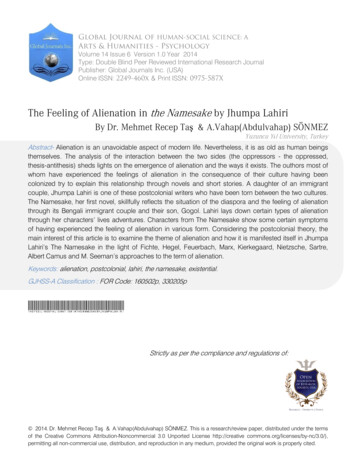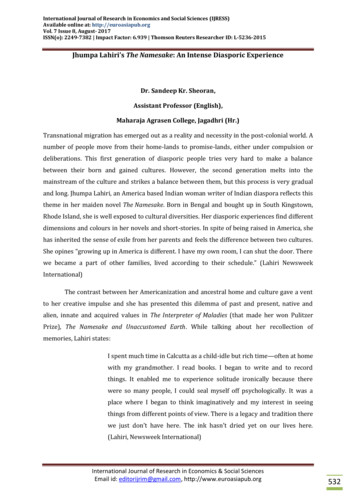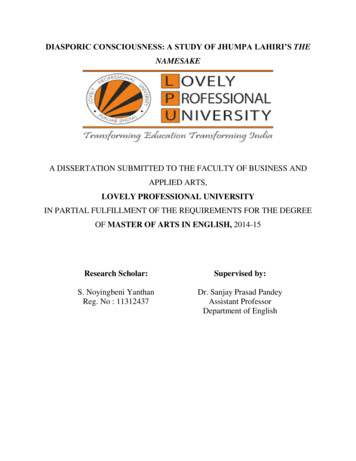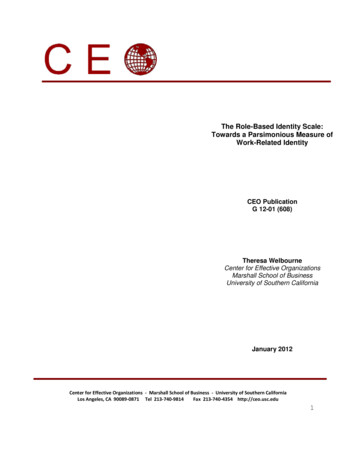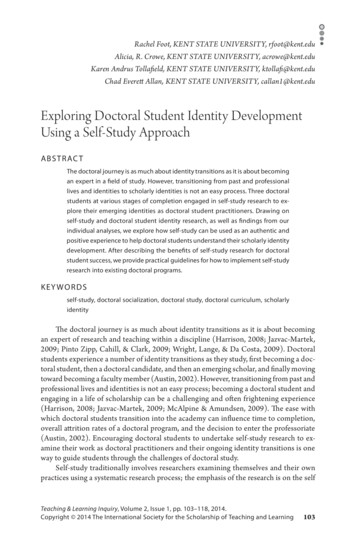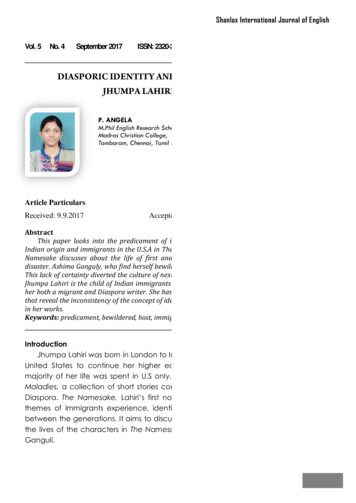
Transcription
Shanlax International Journal of EnglishVol. 5No. 4September 2017ISSN: 2320-2645UGC Approval No: 44248Impact Factor: 3.125DIASPORIC IDENTITY AND CULTURAL ALIENATION INJHUMPA LAHIRI’S THE NAMESAKEP. ANGELAANGELAP.M.Phil EnglishEnglish ResearchResearch s Christian College,Tambaram, Chennai,Chennai, TamilTamil Nadu,Nadu, IndiaIndiaTambaram,Article ParticularsReceived: 9.9.2017Accepted: 14.9.2017Published: 30.9.2017AbstractThis paper looks into the predicament of identity and belongingness of the characters of theIndian origin and immigrants in the U.S.A in The Namesake, the novel written by Jhumpa Lahiri. TheNamesake discusses about the life of first and second generation immigrants and their culturaldisaster. Ashima Ganguly, who find herself bewildered in between the native culture and host culture.This lack of certainty diverted the culture of next generation and gave a cultural break. The fact thatJhumpa Lahiri is the child of Indian immigrants when she migrates from England to America makesher both a migrant and Diaspora writer. She has written on the Indian Diaspora and narrated storiesthat reveal the inconsistency of the concept of identity and cultural difference in the space of Diasporain her works.Keywords: predicament, bewildered, host, immigrants.IntroductionJhumpa Lahiri was born in London to Indian parent’s in1967. She later moved to theUnited States to continue her higher education. Though she is an Indian by birth,majority of her life was spent in U.S only. As a writer, her first book was Interpreter ofMaladies, a collection of short stories connected with Indian-American identities andDiaspora. The Namesake, Lahiri’s first novel was published in 2003. It deals with thethemes of immigrants experience, identity and displacement, and ties and clashesbetween the generations. It aims to discuss and question the sense of displacement inthe lives of the characters in The Namesake and especially its main character GogolGanguli.95
Vol. 5No. 4September 2 017ISSN: 2 32 0-2645As we take distance from the colonial world when the transaction of cultures andidentities seemed to be obligatory for the people who lived in such an era, we getcloser to the world of transnationalism where that obligation seems to be intentional.This means that people in post-colonial times are not necessarily forced by war orcolonization to abandon their homes or live under the hegemonic control of a foreigncountry. They have more freedom to move and choose where to live. Nevertheless,the later consequences of this movement are unknown and cannot possibly becontrolled by these people. In this sense, they intentionally begin a new life in a newplace that will have its own new necessities and obligations which can be unknownand unpredictable to them.If there is displacement in today’s world, it is not exclusive for the immigrants andtheir following generations: everyone in whatever situation, immigrant or not, is liable tobe displaced. The borderline between the ethnic or cultural past and presentdissipated. Therefore, effects of a powerful ethnic or cultural past are not likely to lastfor a considerable period of time. Moreover, American culture, which is a blend ofdifferent cultures, and being American add to the confusion of the characters in thestory.The Indian immigrants involved in The Namesake have an internal dialogue andopposition between their ethnic culture and the culture of the country in which theyabide America. For the children who were born in America, the site of the confusion istheir household or parental home in America where the Indian culture and customs stillexist even if in a diluted form.DiscussionThe life of Indian diasporic communities especially that of women and the social,cultural and religious, racial and ideological conflicts faced by them in the host countrybecomes highly relevant here. The concept of space is very relevant in the study ofdiasporic communities. Cultural otherness, generational and cultural alienation fromtheir ethnic community leaves the Indian diasporic women trapped in a spacebetween the culture of homeland and that of the host country. They lack security andemotional support from their family and this isolation leads diasporic women who areemotionally and economically dependent on their husbands to the problems likedepression, loss and nostalgia.Lahiri’s The Namesake, a cross cultural multi generational story examines thecultural conflicts, pangs, aspirations and dilemmas of the Indian immigrants who findthemselves in between the native and host cultures. Namesake is the story of AshimaBhaduri, a student in degree class who becomes Ashima Ganguli after her betrothal toAshoke Ganguli of Alpire. After marriage they shift to Boston. The book opens withAshima Ganguli who is upset, homesick, spatially and emotionally alienated from herancestral home, trying to recreate the taste of her favorite Indian snack, thereby trying96
Shanlax International Journal of Englishto reconstruct her past. She thinks of her past with nostalgia of her home and spendsher leisure in reading Bengali poems, stories and articles.The first generation especially Ashima finds it very difficult to accustom to the hostculture. Pregnancy was a hard time for her as there was no one to soothe her in thealien land. Motherhood is a glorious stage for a woman but for a migrant in a foreignalien land, loneliness and strange surroundings nearly kill such feelings. She was the onlyIndian in the hospital with three other American women in the adjoining room. Ashima“is terrified to raise a child in a country where she is related to no one, where she knowsso little, where life seems so tentative and spare”. She is always nostalgic about herrelatives in India. After Gogol’s birth she says to Ashoke, “I am saying I don’t want toraise Gogol alone in this country. It’s not right. I want to go back”. Ashoke feels guilty forbringing her to this alien land. But she is determined to bear the pain and to give birthto the infant in an alien land for the sake of the child. She wants her grandmother whois staying in India to assign a name to her new born which shows her desire to hold fastto the conventions of her culture and the resulting disappointment because of thefailure to do so. She suffers from sleep deprivation in a house alone with her baby andshe visits the supermarket where everyone is a stranger to her. Often recalls herparalyzed move out and explore the world, teaches the culture of her own country butnever force them to do or practice it.Ashima is always reminded of the words of her elders who told her “not to eat beefor wear skirts or cut off her hair or forget her family” (The Namesake 37). But the secondgeneration does not abide to these rules and lives a life of their own. The novel in away portrays the problems of acculturation and assimilation faced by the first as well asthe second generation immigrants. Moushumi is a new generation Bengali born andraised in America’s multicultural society and is a peculiar combination of Indian,American and French identities. Her education at New York University, her frequentvisits to France and England changed her perspectives and her native culturalconsciousness. She has little appreciation for India or Indians and is more westernized inher attitude. She has “privately vowed that she had never grown fully dependent onher husband (247). Their marriage relationship that developed in America’smulticultural milieu ends in divorce. The second generation immigrants Sonia when theyvisited Calcutta did not feel alienation and nostalgia in her. She gradually assimilatesbits and pieces of the new cultures unlike Moushumi have a sense of duty and marryher boyfriend a half Chinese boy Ben. She decides to look after her mother after herfather’s death.Ashima like many immigrants Bengali women is not culturally immunized byAmerica’s multi culture, is a strong follower of Indian cultures and gives importance tofamily and relationship. She does her best to perform the role of a homemaker and triesto upload the traditional values against the materialistic values of America. The fear of97
Vol. 5No. 4September 2 017ISSN: 2 32 0-2645losing her Bengali culture and of her children’s neglect of their original culture secretlytorments her.‘Multiculturalism’ suggests the co-existence of a number of different cultures. It doesnot prescribe homogenization and conformity directly. It also does not encourageopenly different ethnic religions, lingual or racial constituents of a particular society todegrade and alienate each other so that such a society is damaged or destroyedpermanently. The Namesake is a perfect reference for Lahiri’s story about thestrangeness of the Indian immigrant experience in the United States and that issomewhat true also because the child of immigrants begins in a kind of nowhereplace. Gogol or even Lahiri is firmly of America but is not quite an American in partbecause they are not recognized as such by others. Gogol desires to blend in theAmerican society. He wants to live unnoticed. But he is not viewed as an American byother Americans, even though he is a native born citizen. He tries to put a wallbetween his past and his present but it is not easy. The adoption of ‘Nikhil’ is a part tolive only in the present, but the ghost of Gogol clings to him that he signs his old nameunconsciously, he does not respond immediately when he is addressed as Nikhil. Hetries to become an entirely different person from what really he is. Gogol struggles tocarry the burden of two names. Nikhil resembles American names, yet ‘Gogol’ and hispast follow him everywhere. He experiences a feeling of being in-between. JhumpaLahiri tries to focus on the issue of identity what she had faced in her childhood. Theproblem of Gogol’s name symbolizes the problem of his identity. He wants to beconnected to the strange names in the graveyard when the students were taken tothe graveyard for the project. He wants to relate himself with American locate but hisname hinders his way to be recognized as an American. Nikhil replaces Gogol whenhe enters Yale as a freshman. Here nobody knows his earlier name. He feels relief andconfident. No one knows him as Gogol but Nikhil. His life with new name also getschanged. Gogol is an outsider in American society whereas he does not feel intimacywith Indianness. So ‘who he is’ becomes a great problem. It is the name whichdetermines identity. Gogol is trying to get identity. Even after making all efforts to erasehis past, his failure to assert his identity is seen in his relationship with women. He doesnot want Ruth or Maxine to meet his parents. Such efforts are made to escape his pastidentity and heritage.Lahiri uses Gogol’s name to, literally and figuratively, represent the ways in which iscultural heritage serves him from the social sphere, forcing a gap between him and hisAmerican friends, and serving as a constant reminder of the depth of this disparity. Healready knows that his Indian heritage sets him apart from his schoolmates, and that hisinner turmoil is evident from young age. He tries desperately to distance himself frombeing Indian. He would rather attend art classes than Bengali lessons and he couldrather listen to Beatles than his father’s classical Indian music.98
Shanlax International Journal of EnglishGogol is often unhappy because it is difficult for him to reconcile the differentcultures, countries, and people that define him. For Gogol, the universal difficulties ofadolescence are compounded because he is the son of first generation immigrants.He begins to address his parents in English, while they speak to him in Bengali. Gogolwants to adopt to American values and life concepts, which are firmly resisted athome.ConclusionThe Namesake is a story of identities. It begins with the migration in the firstgeneration and follows with its specific concerns to the second generation. Alienationis a part of the experience of the Indian diaspora and even if people are at home inany part of the world it does not mean that they will not become victims of the sense ofalienation. The novel depicts how the immigrants face cultural dilemmas in the foreignsystem. The second generation diaspora finds their roots only after undergoing culturalimbalance. Diaspora is all about the creation of new identities. Their own childrengroomed to be ‘bilingual’ and ‘bicultural’ face cultural dilemmas and displacementmore. But at last Lahiri also shows that all immigrants carve their own ‘routes’ in thecourse of time and it’s not necessary that they should settle in the country of their ownorigin.ReferencesPrimary Source1. Lahiri, Jhumpa. The Namesake. New Delhi: Harper Collins Publishers, 2004Secondary Source1. Eagleton, Terry: The Idea of Culture. Oxford Blackwell, 2000.2. Rayaprol, Aparna. Negotiating Identities: Women in the Diaspora, Delhi. OxfordUniversity Press.3. Sinha Aditya. “Review of The Namesake-The Malady of Naming” Hindustan Times,Sept 28, 2003.99
Diaspora. The Namesake, Lahiri’s first novel was published in 2003. It deals with the themes of immigrants experience, identity and displacement, and ties and clashes between the generations. It aims to discuss and question the sense of displacement in the lives of the characters in The
